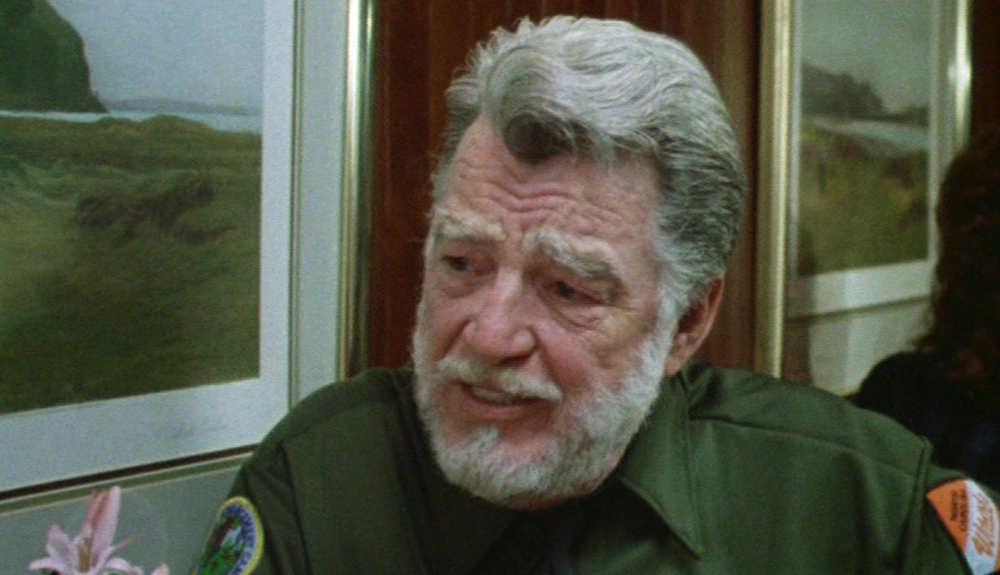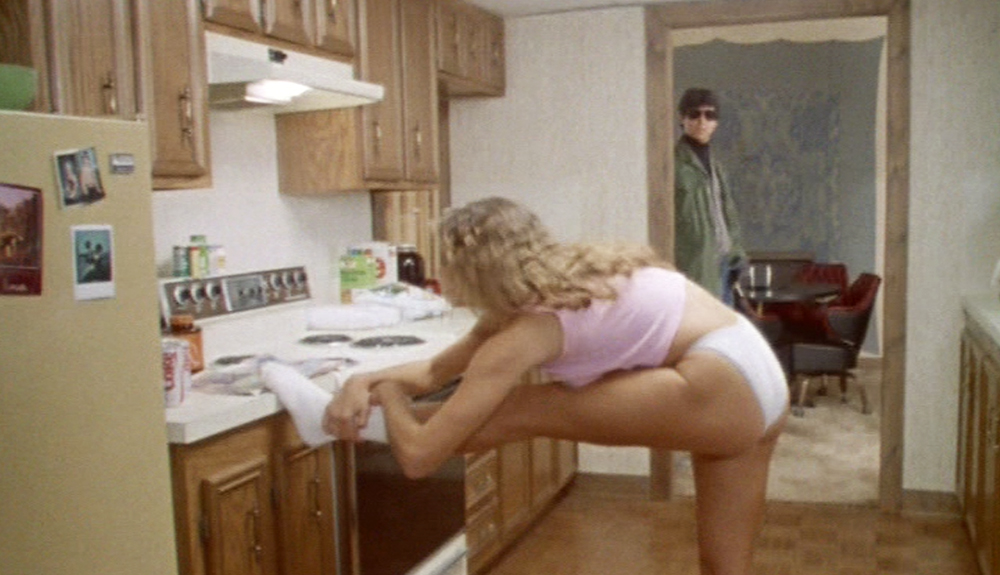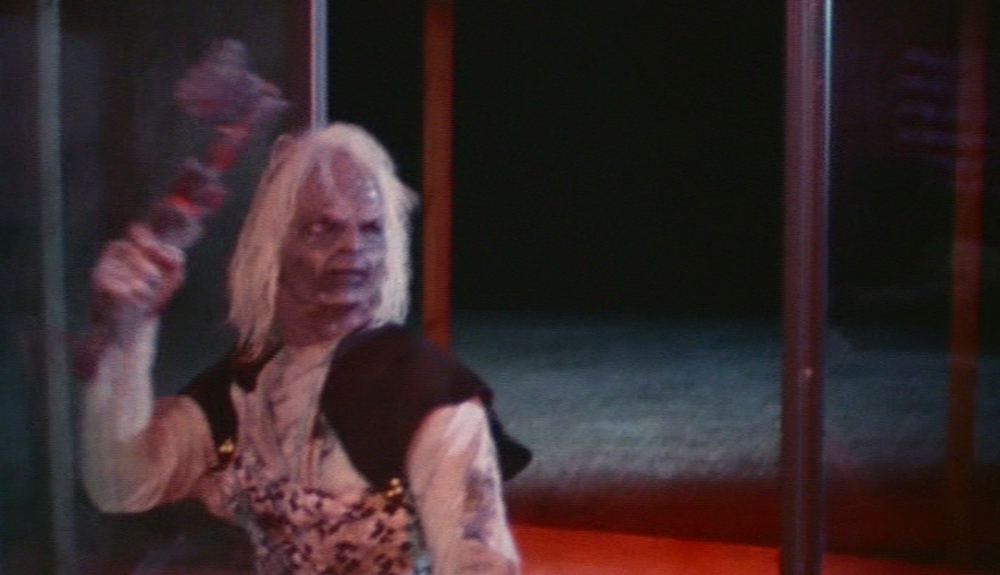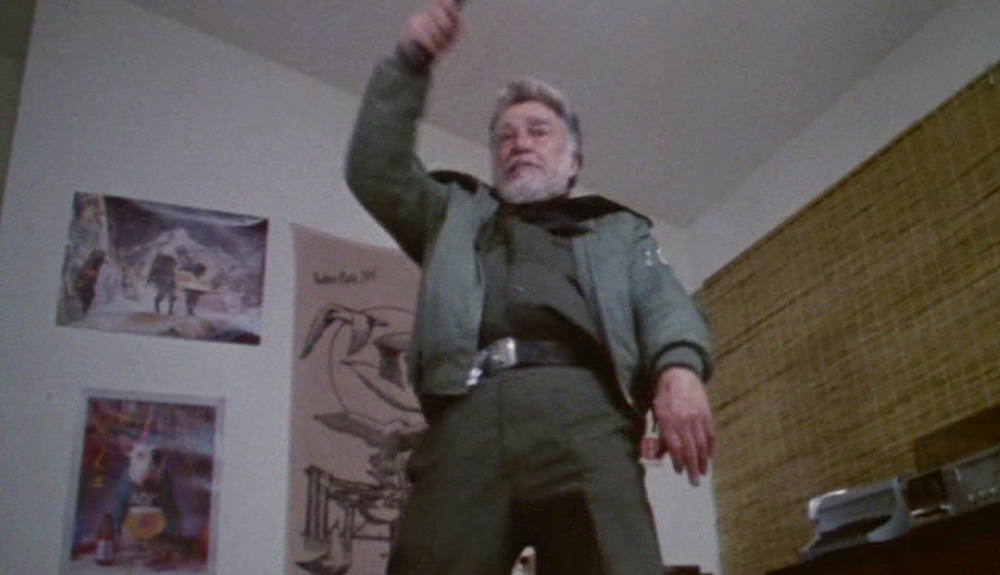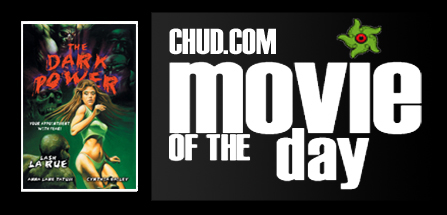
The Film: The Dark Power (1985) BUY IT FROM CHUD!
The Principals: Phil Smoot (Director), Lash LaRue, Anna Lane Tatum, Cynthia Bailey, Mary Dalton
The Premise: “Spam in a Can” flick about a group of kids who move into a house under which EVIL is buried.
Is it Good? Let me tell you just how good:
In 1985, whip-wielding western hero (and one of the inspirations for Indiana Jones) Lash La Rue received his Lifetime Achievement Oscar. The Academy thought it was time. His acceptance speech would make the next morning’s news broadcasts, as he snapped his statuette out of Glenn Close’s hands with his trademark whip.
Lash wasn’t ready to give up the ghost. One year later, that little Lifetime Achievement prize was vying for mantlespace with the Best Supporting Actor statuette he won for his heroic performance in The Dark Power (later that evening, Lash and a disappointed – and coked to the gills – Eric Roberts got into a scuffle at a post-Oscar bash over who was more deserving of the win. La Rue brought his bullwhip. The altercation was short-lived).
La Rue’s victory was hardly the last shot fired by the filmmakers that night, as The Dark Power swept nearly every major category – though Dark Power helmer Phil Smoot lost the Best Director prize to Akira Kurosawa (who nevertheless gave a shout-out to Smoot in his acceptance speech. The Ran filmmaker told Smoot that he “wished there was some way to share this moment with him” as Power had “haunted (his) dreams.” High praise indeed).
The film’s victory lap was marred by controversy, however, as Old Chief Wood’nhead – an 86-year-old man claiming to be descended from a Toltec shaman – led a demonstration outside the Dorothy Chandler Pavilion, protesting both the on-screen depictions of the Toltec people, and lamenting the fact that the production didn’t cast or consult actual Toltecs. Marlon Brando’s participation in said protest lent it real weight.
Smoot’s triumph ushered in a wave of copycat productions; Mississippi Burning, for example, would attempt to piggyback Power’s success three years later by speaking to race/culture fears, though its Oscar fortunes were of a far more limited nature – and the less said about Thunderheart, the better. None of the cash-ins could match the impact of Smoot’s film.
The Dark Power began its life as a small-scale independent feature shot during a chilly North Carolina autumn in 1984. Smoot’s screenplay dealt with the fallout of ever-encroaching modernity on Native American tradition, the generation gap exacerbated by shifting cultural and spiritual identity, and the power we ascribe to myth and magic.
La Rue co-produced and starred in the film as Ranger Girard, a conservation and game officer committed to the humane treatment of wild animals, who discovers that his recently-deceased best friend Four Eagles Cody – a Native American medicine man (brought to life – and death – via a somber, soulful performance by Robert Bushyhead) – has been secretly protecting the people living on his lands from the sinister spiritual presence of Toltec sorcerers. In the absence of Four Eagles, however, the magicks of the Toltecs go unchecked and the titular Dark Power arises – threatening to destroy a small, racially-charged community.
The Toltecs predated and informed Aztec culture, and it has been said that they completely dominated what is now known as Tula de Allende, north of Mexico City. While many scholars see the Toltecs as purveyors of art and culture, there are those who believe that the history of the Toltecs is merely an invention/embellishing of their exploits by the Aztecs, and is therefore of suspect significance. This speculation served as the springboard for Smoot’s dark-hued cultural observations. The director used the arguments of academia to re-purpose the Toltecs as a cruel culture, whose strength and rule was derived from a mastery of dark arts (clearly, Mel Gibson pilfered this concept whole cloth in 2006 for his Apocalypto). Those on the journey knew that they were making something important and memorable – but they had no idea how beloved their film would become…no idea it would win so many Oscars…and no idea how fondly it would be remembered some twenty-five years later.
I think I’ve probably laid it on thick enough for long enough. The Dark Power is obviously not an Oscar-winner. It is, in all actuality, a truly goofy slice of regional horror – and although I prefer my Elseworlds Oscar telecast (’cause frankly, fuck Out of Africa), the cruel fact of the matter is that Phil Smoot’s charmingly goofball film didn’t receive a single Academy Award nomination. Criminal.
The Dark Power is basically a haunted house flick – but the house is the least creepy bi-level in the history of cinema. Smoot did have a point in setting the film in such environs – he wanted to tap into that age-old idea that something terrifying can lurk under the safest veneer…
…or maybe it was the only house the production could find. Either/or, I guess.
The film begins with an exploitative explanation of Toltec culture – which differs quite a bit from anything approaching historical truth – and basically turns the Toltecs into spooky monsters, informing us that they were into black magic and ritual sacrifice.
We’re then intro’ed to the aforementioned Four Eagles Cody on his deathbed, where he speaks a weak, one-word warning: Toltec. At his side in his last moments is Mary Dalton, a reporter chasing a story about living wills and legalities – but it is here that her attentions turn to the local legend’s last utterance. This setup should be your first indicator that this film is dementedly off-kilter. Smoot and his peeps are obvious film fans, and I can’t help but think they were laughing their asses off at the idea that they were beginning their micro-budge Z-pic with a shameless lift of Citizen Kane.
Upon Cody’s passing, we discover that his son David, heedless of his father’s dying protests, insists upon carving his father’s land into lots and making a killing at the white man’s real estate game. He immediately hires handyman Earl Colman (Paul Holman – whose performance suggests he’d have felt right at home on the set of any “Ernest” film), to tidy up his father’s house, and to specifically rid the property of his father’s ceremonial totems. At one point, Earl tells Lash La Rue’s Ranger Girard that Four Eagles’ son is “working him like a nigger,” and he wonders aloud if the “faggot lawyer” is going to give him more work to do (come to think of it, Mel Gibson might have been deeply influenced by this film). He’s just one of the stunningly racist, obnoxious characters in the film – yet, to the filmmakers’ credit – every one of these individuals is quite obviously a fucking moron, and they almost all find a bloody end.
While rummaging through Four Eagles’ belongings, Earl notices a strange sculpture of an eagle perched atop a skull. Ranger Girard has seen this symbolism before; he explains that the skull is the symbol of a dark power, and that the eagle is perched atop it, “to control the dark power.” Earl thinks this closet full of Native American trinkets “smells like a fart” – he’s so nonplussed that he doesn’t even bother tossing the stuff in the trash.
Not so-good-son David eventually sets up Four Eagles’ former homestead as off-campus lodging, and thus a group of Southern-sassy college girls move in. There’s Beth (Anna Lane Tatum) – our studious and winsome Final Girl, Suzan (Suzie Martin) – a bubbly little ’80s perm whose defining characteristic is that she’s a fitness freak (which means that her wardrobe consists of whatever the producers could swipe from the set of The 20 Minute Workout), Tammie (Cynthia Bailey) – a sweet-natured African-American girl, and Lynn (Cynthia Farbman) – the standard-issue shitty roommate. Another one of the film’s insanely over-the-top-racists racists, Lynn is instantly incensed that a black girl’s moving in, and she expresses her frustration in the subtle, codified fashion of the day:
“You two bring that nigger in here right under my nose, and beg her to live with us? If she moves in she’ll probably coerce a whole bevy of her gyrating friends in here!”
Ahem. Times sure have changed. Nowadays, racists just ask for a birth certificate…
As Beth gives a trepid Tammie a tour of the home, they discover the closet full of Toltec artifacts – and Tammie proves herself knowledgeable with regard to Toltec lore, explaining to Beth that, “Toltec sorcerers are bad dudes.”
In retaliation for the African American roomie, Lynn moves her smarmy dickhead of a brother, Craig (Marc Matney), into the house. Craig brings with him a batch of awful/awesome one liners – my fave has to be when he spots the fit and flexible Suzan in her workout wear. Shocked that there’s suddenly a man in the house – she screams, “What are you doing in here?!”
Craiggers half chuckles, brutally ogles* her, and says – “I know what I’d like to be doing in here.” His delivery only adds to the peerless stupidity.
Joining Craig is a batch of his drunken douchebag friends, who intentionally spill beer on themselves, fall off of couches, and make a shit ton of racist jokes about poor Tammie. Ostensibly added to the mix to annoy Lynn’s other roomies into leaving – they really only exist to be Toltec fodder, as shortly after the assholes arrive…and night falls…the demonic Toltec sorcerers rise from the Earth to murder everyone in sight!
From here, the roommates are dispatched in woefully, wonderfully under-budgeted fashion. What the film lacks in gore, however, it makes up for with fantastically dorky comedy. One of the Toltecs, a manic little goon who vaguely resembles latter-day David Lee Roth, carries two tomahawks everywhere he goes. He’s constantly spinning them about as if he were channeling Bruce Lee – but when it comes to actually utilizing them, he proves embarrassingly, hilariously enfeebled. At one point, he tosses one of his axes right into a fellow sorcerer’s chest (while aiming for a victim) – and reacts with a broad “oopsie” shrug. The movie is clogged with moments like this. The Toltecs get drunk…they sample breakfast cereal…they’re mesmerized/frustrated by anything modern.
As the Toltecs wreak havoc, Mary investigates the lore of the land alongside a kid who appears to be America’s first attempt to clone C. Thomas Howell – and discovers a shocking truth. Four Eagles Cody really had been guarding the land against the return of the Toltecs – a return he had discovered was prophesied to take place this very evening (in the film, not tonight). Mary warns Ranger Girard, and he whips into action to save the college kids – but can he get to them in time?
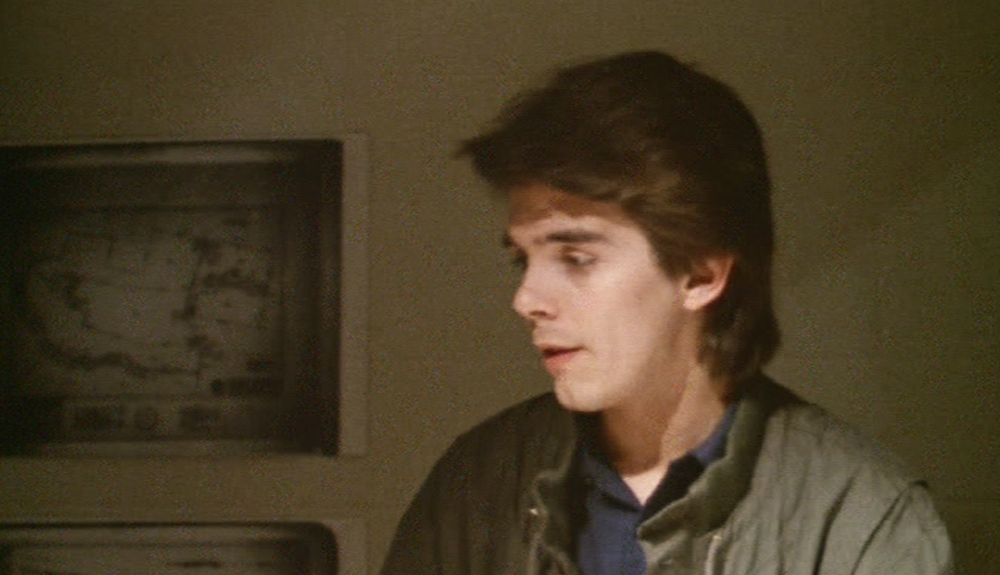
C. Homas Towel’s career needs resuscitation – perhaps a cameo in the next Webb Spider-Man film is the answer…?
The film climaxes in truly epic fashion, as the fate of the world hinges on the WHIP FIGHT between a centuries-old South American Shaman in pajama bottoms…and an eighty-five-year-old park ranger. Did I mention this clash of the titans takes place on the second-story deck of a too-sweet bi-level? It’s like Evil Dead happened at your mom’s house. Or like Donald Pleasance and Michael Myers decided to fence on the balcony at the end of Halloween. The Dark Power is a wonderfully giggly slice of cheese that you’ll be quoting for awhile after you see it. So you should probably do that soon.
The film is easy enough to find at Amazon (though they claim there’s only one left in stock right now) – or directly from VCI Entertainment, where you can also find it packaged with Phil Smoot’s other film, Alien Outlaw – or as I like to call it, Hillbilly Predator…’cause, well…that’s exactly what it is.
Random Anecdotes: Mary Dalton was an actual reporter in North Carolina – she’s now a published author and University Professor. Editor Sherwood Jones has gone on to cut a number of terrifying films – including a few of the DTV Mary-Kate and Ashley titles. Cynthia Bailey carved out a career as a model and trophy wife – as she’s now one of the Real Housewives of Atlanta.
Cinematic Soulmates: Evil Dead II, Texas Chainsaw Massacre II, Halloween
*shamelessly stolen from Edgar Wright
